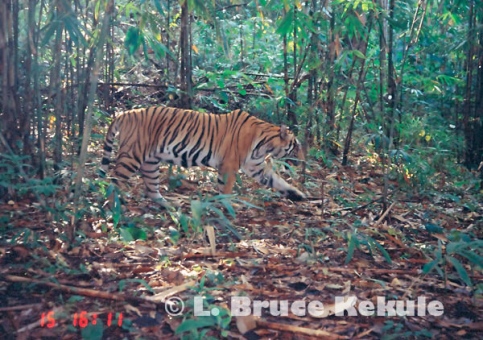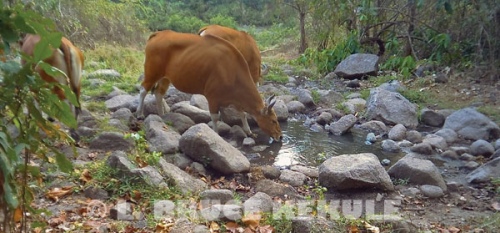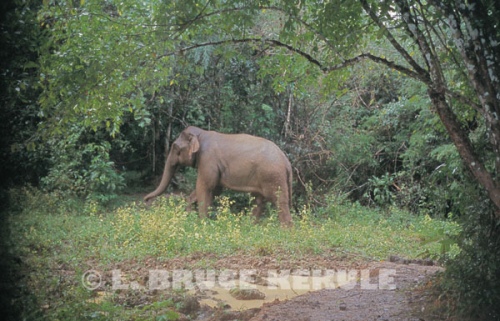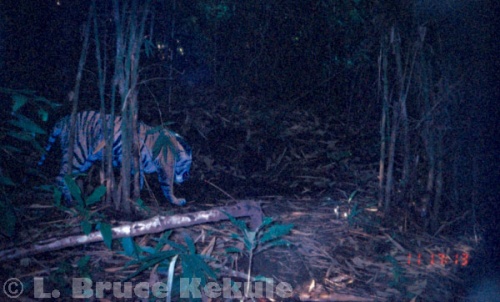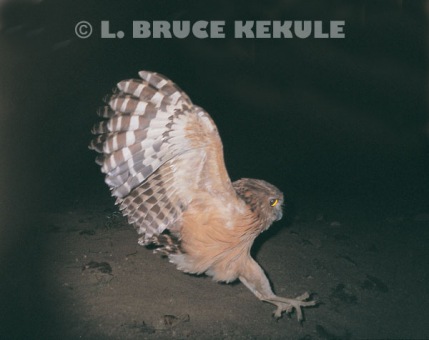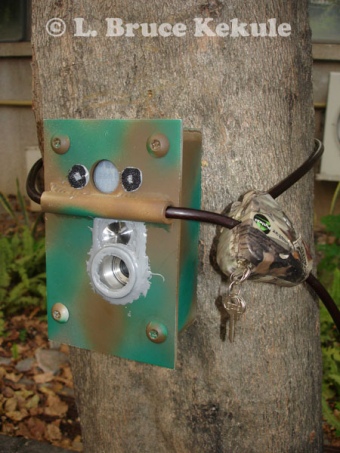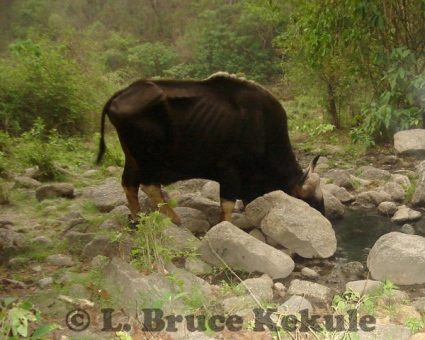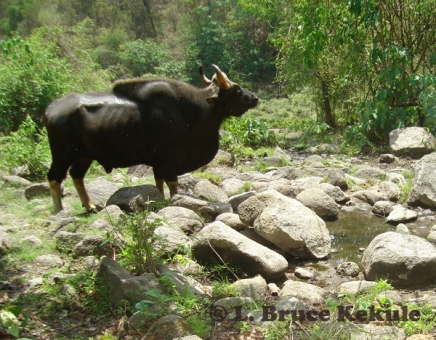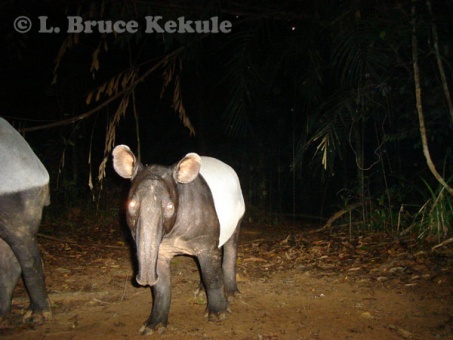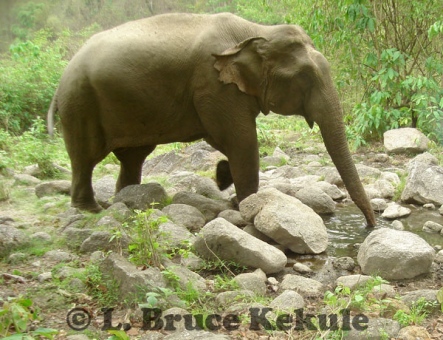Wildlife Candid Camera – Infrared cameras ‘trap’ Thailand’s elusive wildlife
Wildlife Candid Camera – Infrared cameras ‘trap’ Thailand’s elusive wildlife
Indochinese tiger camera trapped in Sai Yok National Park
One evening as the shadows were melting into darkness in the jungle of Sai Yok National Park, an Indochinese tiger Panthera tigris corbetti was meandering up to a forest pool for his evening drink. At the planned position, a camera-trap mounted on a dead tree tripped a photograph of the cat, causing it to bound into a bamboo thicket. The tiger could not of course have understood exactly what had just taken place. Instinct triggered its reaction to the flash and the camera’s mechanical click. Taking a photograph of a tiger in the wild is a very daunting task but the wizardry of modern electronics has made the job much easier.
Gaur herd caught at a mineral deposit in Kaeng Krachan National Park
A few days later and just two kilometers away, another tiger pads slowly through the forest topping a 600-meter-high ridge in late afternoon. Its senses are on high alert for any movement or sound that could lead to its next meal. A passive infrared camera-trap set on a wildlife trail catches the tiger as it passes through an invisible motion-detection field. The time and date is recorded and the wildlife photographer has just triumphantly photographed one of Thailand’s rarest mammals in the wild – without even being there at the time; a rare candid wildlife photograph set off by the subject itself.
Mother and cub in Huai Kha Khaeng Wildlife Sanctuary
Far away in Huai Kha Khaeng Wildlife Sanctuary in Western Thailand, a mother leopard guides her young cub to a sambar kill. The carcass is ripe after a few days but still good for a full meal. In early-morning darkness the leopards trigger an active infrared SLR camera and strobe strategically positioned close to the dead deer. When the film was processed, I saw two feeding leopards – a mother and its cub. The female is yellow but the young one is black. Photographs of the notoriously elusive leopard would be far rarer if not for modern technology.
The history of camera traps goes back more than a hundred years. In 1906, pioneer wildlife photographer George Shiras III used a flashlight camera with trip wires to photograph wild animals. His equipment was very heavy and very complicated to use, with the lens aperture being very difficult to anticipate. Two other men experimented with camera traps activated by pressure-plates: F.M. Chapman in 1927 and F.W. Champion in 1928. Their primitive traps produced many superb black-and-white photographs that thrilled magazine and book readers at the time.
Banteng herd at a waterhole in Huai Kha Khaeng
For the last four decades or so, researchers and biologists to collect data on wildlife and also to investigate the secretive and nocturnal lives of such rare and endangered species as the tiger and leopard use camera traps. Beyond glamorous predators, species such as wild cattle, deer and pig are also, without discrimination, recorded to reveal such useful information as relative abundance and activity patterns. Camera trapping can lead to important scientific databases.
The units are most often attached to a tree, usually half a meter above the ground and three to four meters away from water holes, mineral licks, wildlife trails, forest roads or stream beds. The time and date is imprinted on each frame for scientific research.
An American hunter whose goal was to survey designed one of the first camera traps utilizing infrared technology and scout possible locations for big game like deer and bear. These active infrared sensors manufactured by TrailMaster.com in Kansas used a separate transmitter and receiver connected to a small ‘point-and-shoot’ camera which is triggered when the beam between the two units is interrupted by any moving object. A major drawback of active systems is that even an insect momentarily blocking the sensor will stimulate a photograph of seemingly empty forest. Active infrared camera traps are best suited to conditions that are dry with minimal insect activity. Further, three separate units are quite complicated to set up and maintain.
Problems with active infrared systems caused a researcher in Texas to ask a friend to develop a passive infrared camera trap, leading to the establishment of CamTrakker.com in Georgia. Passive camera-traps are a self-contained unit with the camera, batteries and sensing electronics sealed in a box. The sensor detects motion. The chief advantage of the passive system is the ease of a single unit installation with no alignment or external wires.
Asian leopard feeding on a sambar carcass in Huai Kha Khaeng
Passive infrared camera traps, which can work for one month or more between battery changes, have proven the most utilitarian for both researchers and wildlife photographers. The relatively high cost of commercial units is the major drawback, particularly to budget-strapped researchers in developing countries.
Both TrailMaster and CamTrakker have steadily improved their equipment over the years. Other companies have now joined the competition, bringing prices for entry level units down to about US$250 (Top-of-the-line models are about US$500 and CamTrakker offers a digital model that costs US$1,200).
Throughout my early years of wildlife photography, the thought of camera trapping had frequently crossed my mind. Finally, with many years of mechanical experience, I decided to build my own camera-traps. Using existing units as a model, I built a passive infrared camera-trap housed in a 6” x 6” tig-welded aluminum alloy box with a removable front cover. The camera-trap as an enclosed unit that is fixed to a tree using two stainless steel lag bolts contained within the box. A small bag of dessicant (silica gel) is set inside to protect the delicate electronics and camera from moisture, and the front cover is hermetically sealed using silicon sealant and stainless steel screws. The unit is elephant-proof that is very important in the forests I work in. Elephants destroy plastic camera-traps.
Tuskless bull elephant in Kaeng Krachan
Out of my home workshop, I was able to make these custom-built cameras for way less than half the price of imported commercial units. My very close friend Yutdhana Anantavara from Chiang Mai modified the cameras and installed the infrared electronic systems. This early work really helped me onto the road to successful home-made camera traps.
Feral cat camera trapped at my home in Chiang Mai
The first batch of prototype units employed several brands of ‘point-and-shoot’ cameras and different experimental housings. To evaluate each camera’s quality and reliability, I intensively tested each on the domestic cats that regularly walked on top of a wall behind my machine shop. Various films were tested but slide film at 400 ISO proved to produce the highest quality image.
My 1st camera trapped tiger in Sai Yok
To field test the new gear I took a trip to Sai Yok National Park in western Thailand. All of the cameras were placed along wildlife trails, waterholes and mineral licks. Over several months, the film was collected and developed. I was ecstatic when I saw two different tigers, an elephant, serow, muntjac, stumped-tailed macaque, bear, porcupine, water monitor, jungle fowl and wild pigs. The omnivores were the most frequently photographed and probably the tiger’s main prey species. A totally unexpected bonus was photographs of a few poachers.
Serow male camera trapped in Kaeng Krachan NP
Numerous camera trap surveys have been conducted in many of Thailand’s forests. A 2001 survey produced a photograph of a Siamese crocodile in Kaeng Krachan National Park. The croc was caught in broad daylight on a sandbar along the river. Park staff set cameras for a month along the Phetchaburi River. The amazing discovery of this very rare reptile has prompted more investigation into this endangered species. In 2003, I camera trapped a crocodile in Khao Ang Rue Nai Wildlife Sanctuary.
Wild Siamese crocodile camera trapped in Khao Ang Rue Nai Wildlife Sanctuary
To analyze wildlife in a given area, researchers use two main techniques: a trail-based survey (where cameras are randomly placed along wildlife trails and roads covering 100 to 300 square kilometers) and a more intensive plot-based method. A smaller plot is chosen (usually 40-50 sq. kilometers) and a camera is placed in each one-kilometer grid. An area can eventually be exhaustively surveyed – the duration depending on the number of cameras used – to prove the presence or absence of tigers and other animals. The data then can be used for conservation management of the protected area.
Indochinese tiger abstract in Kaeng Krachan
Camera traps can reveal very disturbing information. Extensive surveys around Khao Yai National Park indicate that only two tigers survive. The patterns of tigers are as unique as human fingerprints so it is essential to get photos of both sides of each animal so that individuals can be identified. Researchers often set cameras on either side of a trail to capture both sides simultaneously. Khao Yai might have more tigers but the fact that only two individuals are confirmed is depressing. As of 2005, no tigers have been seen in intensive surveys carried out by Kate Jenks from the Smithonian Institute.
Indochinese tiger camera trapped abstract
Poachers have also been camera trapped here. Usually they walk obliviously past the camera but they sometimes damage or steal cameras. Elephants also destroy cameras, tearing the plastic commercial housings off the tree and smashing them or lobbing them into the bush. A Royal Forest Department researcher at Hala-Bala Wildlife Sanctuary in the deep south of Thailand found a unit damaged by elephants, but the camera was still working and developed the film. The last frame shows a very close view of an elephant’s trunk! Some researchers have built stronger steel boxes to protect the plastic units.
Buffy fish-owl landing by the Phetchaburi River in Kaeng Krachan NP
My aluminum-cased camera-traps firmly bolted to a tree have survived many inquisitive elephants. However, they can be stolen or vandalized by determined people who do not want their photo taken. In May of 2005, I lost three cameras near the headwaters of the Phetchaburi River in Kaeng Krachan National Park. Forest fires in the dry season destroy cameras. Insects will invade the interior of imperfectly sealed units, playing havoc with their operation. High humidity in the rainforest also damages electrical circuitry, cameras, film and batteries not protected by a well sealed unit and a small bag of moisture absorbing silica gel.
Infrared camera trapping has undoubtedly become a uniquely useful tool for conservation biologists. This ‘candid camera’ is also a blessing for wildlife photographers wanting images of rare and endangered animals. Who knows? In the future, a camera-trap could photograph a species new to science. I’m always excited when I get camera-trap film back from the lab. But the digital age had arrived. Film is being slowly phased out and digital cameras have now overtaken the market dominating it.
Asian Leopard hunting on old logging road in Kaeng Krachan NP
***************************************************************************************************
Wildlife Candid Camera: The Digital Age has arrived
LBK camera trap attached to a tree using Python locking cable
LBK camera trap with Yeticam board and Sony W7 in custom aluminum case
Digital camera traps have now become the new sensation, especially the home-brew (self-made) market. It is now a huge business with a few companies vying for market share. The most predominant are Snapshotsniper.com and Yeticam.com, and they offer parts (sensor boards, lens, battery packs, cases, etc.) to the home builder.
Very old bull gaur at a waterhole in Huai Kha Khaeng WS
My friend Chris Wemmer, the ‘Cameratrap Codger’, was the first person to tell me about a new company in the US producing infrared circuit boards and other accessories for the home-brew camera trap market. The company is Pixcontroller.com. Unfortunately, they no longer offer parts but now sell completed units with digital camera and video.
Mature bull gaur at water hole
As a wildlife photographer, I decided to produce my own digital camera traps using passive infrared circuit boards acquired from the U.S., and digital cameras modified locally with housings and constructed from tig-welded aluminum alloy at my machine shop at home in Chiang Mai. The first cameras used Nikon L11 and L14 cameras and Snapshotsniper boards that were set-up in the forest of Kaeng Krachan National Park in Phetchaburi province in Southwest Thailand over a three-month period in October to December 2008.
Asian tapir – mother and calf in Khlong Saeng WS, Southern Thailand
Animals captured were elephants, gaur, tiger, sambar and muntjac. One camera had over 300 captures in one month at a mineral deposit in the park.
Asian tapir calf in Khlong Saeng
Down in Khlong Saeng Wildlife Sanctuary in the first part of 2009, I set both film and digital camera traps deep in the forest. Elephants, gaur, tapir, sambar, muntjac, golden cat and Argus pheasant were captured.
Tuskless bull elephant camera trapped at waterhole in Huai Kha Khaeng
I now have more than a dozen digital camera traps using primarily ‘Sony S600’ and W5-7 cameras, Snapshotsniper.com and Yeticam.com circuit boards.
Tusker elephant in Khao Ang Rue Nai Wildlife Sanctuary
The Sony cameras have been the best and most durable due to the manual features like ISO and f.stop adjustments. Picture quality with the ‘Carl Zeiss’ lens is usually good.
A herd of wild pigs including a runt in Khlong Saeng
Camera trapping has allowed me the sheer pleasure of seeing Thailand’s amazing wildlife on both film and digital. As of this writing, I have expanded my camera trap fleet to more than 20 units and continue to run a trap-line in Sai Yok National Park. On my first setting in July 2011, I got a mature Gaur bull up a hill in the interior. Still waiting on a tiger.


